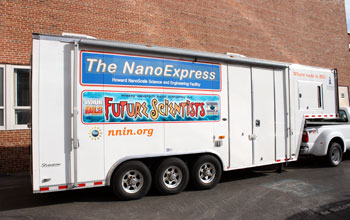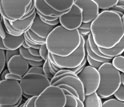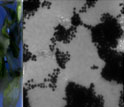News Release 12-099
NSF Announces Six Partnerships for Research and Education in Materials Awards
Projects will investigate materials for renewable energy, advanced electronics, biomaterials, organic and polymeric materials

Howard University's NanoExpress is a mobile science theme park.
May 23, 2012
This material is available primarily for archival purposes. Telephone numbers or other contact information may be out of date; please see current contact information at media contacts.
The National Science Foundation (NSF) has announced six Partnerships for Research and Education in Materials (PREM) awards as a result of the 2012 PREM competition.
The objective of the PREM program is to broaden participation of underrepresented minorities and enhance diversity in materials research and education. This is accomplished by stimulating the development of formal, long-term, multi-investigator, collaborative research and education partnerships between minority-serving colleges and universities and NSF's Division of Materials Research (DMR)-supported centers, institutes and facilities.
The awards were made as part of the fourth PREM competition since the program was launched in 2004.
"DMR is excited by the impact these partnerships will have in continuing to improve the diversity of the materials science and engineering workforce," said Ian Robertson, division director for DMR. "The Division of Materials Research also acknowledges and thanks other divisions within NSF for contributing to the success of this important program."
These awards were made possible through partnership with DMR; the EPSCoR program in NSF's Office of Integrated Activities; and the Historically Black Colleges and Universities Undergraduate Program and Research in Disabilities Education program in NSF's Education and Human Resources directorate.
All six PREM projects have partnerships with Materials Research Science and Engineering Centers (MRSECs) in this round of awards. The PREMs and their partners are listed below in alphabetical order by institution.
The California State University, Northridge PREM will expand and strengthen a long-term partnership between the Computational Materials Theory Center at California State University, Northridge and the Princeton Center for Complex Materials MRSEC. The PREM will apply theoretical and computational techniques to study fundamental charge transfer and separation issues in photovoltaic solar cells, quantum phenomena in 1-dimensional systems like graphene, and advance understanding of electronic structure and electron-spin transport properties in devices such as magnetic tunnel junctions used in computer hard drives. Additionally, the PREM plans several outreach activities including: organizing a summer materials science camp for high school teachers, computational summer schools and workshops focused on undergraduate and graduate students and a materials camp for high school students.
Howard University's PREM, the Partnership for Reduced Dimensional Materials (PRDM), will focus its research in several areas, including advanced thin films, atomic membranes, fabrication of nanowires and the study of transport properties in nanowires. There are numerous applications for these structures in almost every technological sector from electronics to medicine. For instance, advanced materials may enable development of low cost display screens in mobile devices or new sensors to diagnose diseases. Along with Prince George's Community College, Gallaudet University and the Cornell Center for Materials Research MRSEC, the PRDM will develop educational materials science software, conduct outreach activities, such as hosting a nationally broadcast weekly radio show, NanoTalk, and bring science experiments to local schools through the NanoExpress mobile laboratory.
The Jackson State University PREM will pursue fundamental bio-related materials research and educational activities in the following areas: developing magnetically and mechanically-active tunable hybrid biomolecular gels; designing multifunctional nanostructured materials for biology and the environment; and understanding biophysicochemical interactions at the nano-bio interface. Investigating the tunable interfacial mechanics between gels and substrates will lead to a deeper understanding and control of biomolecular systems while the other two research projects will directly impact biosensors and detectors. Many educational and outreach activities are planned, including NanoDay events at local high schools, the Mississippi Museum of Natural Science and the Memphis Zoo, as well as the development of a cooperative materials science Ph.D. program in partnership with the University of California at Santa Barbara MRSEC.
The Norfolk State University PREM will collaborate with researchers from the University of Michigan's Center for Photonic and Multiscale Nanomaterials MRSEC, Purdue University and Cornell University to investigate metamaterials (MMs), which are artificial materials that exhibit properties not found in nature. Specifically, they will seek to understand more about the physical, chemical and other unique optical properties of the next generation of MMs; the interaction of MMs with light and matter; and the development of MM-based devices and components, including transformation optics, quantum optics, cloaking and other stealth technology. The PREM will broaden the impact of its research through undergraduate research experiences, high school summer internships and reaching out to local schools with hands-on workshops.
The PREM Center: Interfaces in Materials at Texas State University - San Marcos, in partnership with the North Carolina Research Triangle MRSEC, will study controlled assembly of nanoscale objects in two main areas. One research thrust seeks to advance the use of applied force to assemble nanoplatelets, nanoparticles and polymers, while the other thrust focuses on assembly and regulatory processes of proteins. The PREM intends to create a pipeline to success in science, technology, engineering and mathematics (STEM) education through a network of interacting educational and outreach programs, including a shared mentorship program that spans the range of elementary school students to PREM faculty, and a PREM Academy to train high school teachers.
The University of Texas at El Paso PREM will partner with the University of California at Santa Barbara MRSEC to pursue research at the cutting edge of photovoltaics. The partnership will aim to develop new materials that will enable a basic understanding of the molecular, supramolecular and interfacial structures that are all part of the "sandwich" of materials needed to collect electrical charges. Improving the interactions at the interface of the materials is essential for development of more efficient photovoltaics. The PREM also plans undergraduate summer exchange programs and international workshops to enhance and broaden the impact of their research. Their outreach activities will include the ExciTES Summer Institute, which will target middle and high school students for summer experiences in materials research, and the creation of the Materials Science Ambassadors program, modeled after the UTEP Engineering Ambassadors program, which seeks to have UTEP undergraduate and graduate students conduct outreach to Santa Barbara high school students and teachers.
These new partnerships will impact a wide range of materials research and education, including nanomaterials and nanotechnology, biomaterials and biotechnology, electronics, spintronics, soft materials, polymers and materials for renewable energy.
Each PREM has made a substantial commitment to effectively integrate its educational and outreach activities with its scientific research program towards the PREM goal of broadening participation for under-represented minorities in materials research and education, and enhancing diversity at all academic levels. The educational outreach activities cover the entire range from elementary school to the postgraduate level.
Each award, resulting from NSF solicitation NSF 11-562, is for five years. These awards, including the 8 PREMs awarded in 2009, bring the total to 14 PREMs with an annual NSF support of $5.93 million.
-NSF-
-
Micro-crystals of alpha-Zirconium phosphate are a source of platelets with nanometer dimensions.
Credit and Larger Version -
Popcorn-shaped nanoparticles (right) can selectively detect a type of Salmonella bacteria.
Credit and Larger Version
Media Contacts
Lisa Van Pay, NSF, (703) 292-8796, email: lvanpay@nsf.gov
Program Contacts
Sean L. Jones, NSF, (703) 292-2986, email: sljones@nsf.gov
Mary E. Galvin, NSF, (703) 292-8562, email: mgalvind@nsf.gov
Related Websites
PREM website: http://prem-mrsec.org/
PREM Program: http://www.nsf.gov/funding/pgm_summ.jsp?pims_id=5439&org=DMR
The U.S. National Science Foundation propels the nation forward by advancing fundamental research in all fields of science and engineering. NSF supports research and people by providing facilities, instruments and funding to support their ingenuity and sustain the U.S. as a global leader in research and innovation. With a fiscal year 2023 budget of $9.5 billion, NSF funds reach all 50 states through grants to nearly 2,000 colleges, universities and institutions. Each year, NSF receives more than 40,000 competitive proposals and makes about 11,000 new awards. Those awards include support for cooperative research with industry, Arctic and Antarctic research and operations, and U.S. participation in international scientific efforts.
Connect with us online
NSF website: nsf.gov
NSF News: nsf.gov/news
For News Media: nsf.gov/news/newsroom
Statistics: nsf.gov/statistics/
Awards database: nsf.gov/awardsearch/
Follow us on social
Twitter: twitter.com/NSF
Facebook: facebook.com/US.NSF
Instagram: instagram.com/nsfgov




